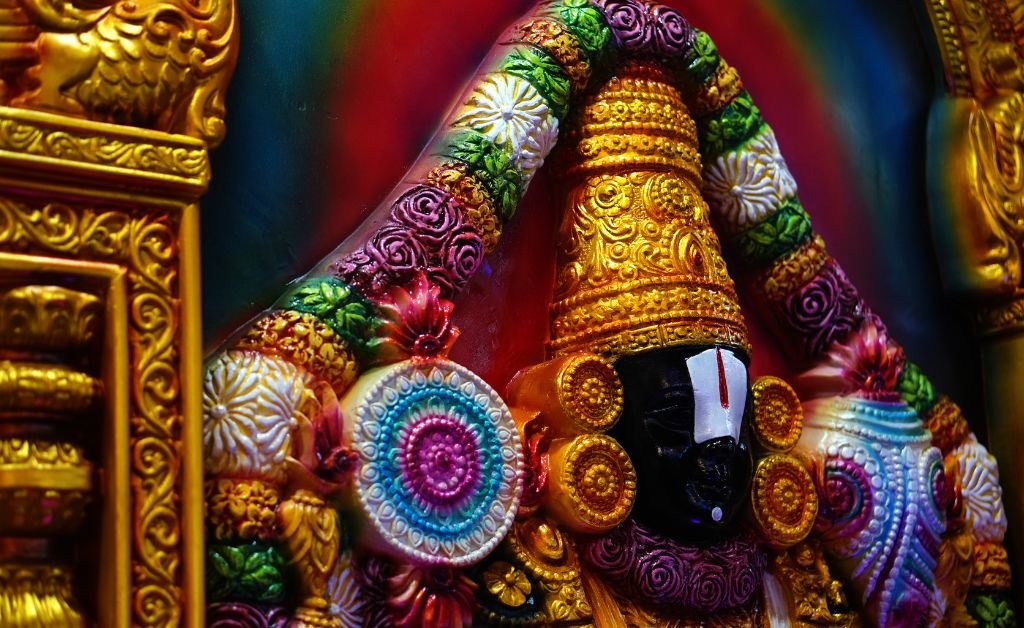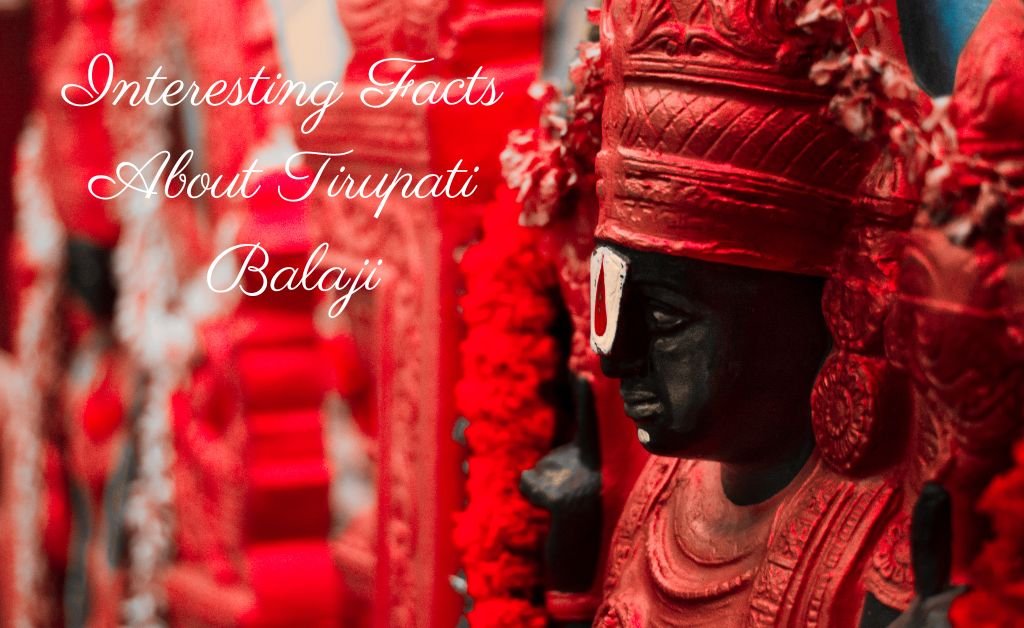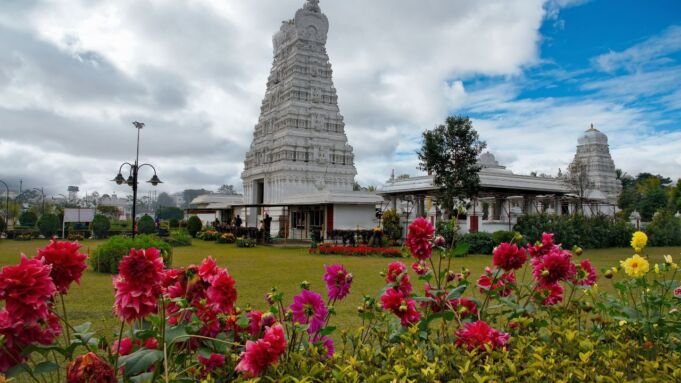Tirupati Balaji, revered as Lord Venkateswara, stands as a majestic symbol of devotion and faith in the heart of Andhra Pradesh, India. Nestled atop the sacred seven hills of Tirumala, this ancient temple is not only an architectural marvel but also one of the most venerated pilgrimage sites in Hinduism.
Lord Venkateswara, an incarnation of Lord Vishnu, is worshipped here with profound reverence, drawing millions of devotees from across the globe each year. The deity’s divine presence, coupled with the temple’s rich historical and cultural tapestry, offers a deeply spiritual experience that transcends the physical boundaries of the world.
Beyond its religious significance, Tirupati Balaji is renowned for its remarkable contributions to society through education, healthcare, and feeding programs, embodying the essence of selfless service and communal harmony. This holy sanctuary serves as a beacon of hope, faith, and unity, inviting all to partake in its timeless spiritual journey.
History of The Tirupati Balaji
The history of Tirupati Balaji, also known as Lord Venkateswara, is steeped in myth and devotion, tracing back to ancient Indian scriptures and traditions. This revered deity is housed in the Tirumala Venkateswara Temple, located in the hill town of Tirumala, near Tirupati in Andhra Pradesh, India. Here’s a brief overview of its rich history:
Mythological Origins
- Incarceration of Lord Vishnu: Lord Venkateswara is considered an incarnation of Lord Vishnu, who descended to Earth to save humanity from the trials of Kali Yuga.
- Self-manifested Idol: The idol of Lord Venkateswara is believed to be svayambhu (self-manifested), making it highly sacred.
Historical Development
- Ancient References: The temple has been mentioned in various Hindu scriptures and texts dating back to the Vedic ages, indicating its ancient origins.
- Early Establishment: While the exact date of the temple’s foundation is unclear, it is believed to have received significant patronage from kings and emperors as early as the 9th century AD.
- Dynastic Contributions: Over centuries, dynasties such as the Pallavas, Cholas, Pandyas, and Vijayanagara Empire have contributed to the temple’s development, enriching its architecture and wealth.
Architectural Evolution
- Dravidian Architecture: The temple showcases classic Dravidian architectural style, characterized by its towering gopurams (gateway towers), intricate carvings, and vast courtyards.
- Expansion and Renovation: Successive rulers and devotees have expanded and renovated the temple complex, adding structures like the main shrine, halls, and the golden roof over the sanctum.
Religious and Cultural Significance
- Pilgrimage Site: Tirumala Venkateswara Temple is one of the most visited pilgrimage sites in the world, drawing millions of devotees annually.
- Spiritual Practices: The temple’s rituals and practices, such as the daily sevas and annual festivals like Brahmotsavam, are deeply embedded in Hindu tradition.
Economic and Social Impact
- Donations and Offerings: The temple is among the richest and most donated to religious institutions worldwide, with offerings from devotees funding meals, education, and healthcare projects.
- Cultural Hub: Beyond its spiritual significance, the temple also serves as a center for promoting Hindu culture, traditions, and arts.
What is Tirupati Balaji?

Tirupati Balaji, also known as Lord Venkateswara, is a manifestation of Lord Vishnu and is the presiding deity of the Tirumala Venkateswara Temple, located in the hill town of Tirumala, near Tirupati in Andhra Pradesh, India. This temple is one of the most sacred and renowned pilgrimage sites in Hinduism, attracting millions of devotees from all over the world each year.
The deity is celebrated for His mercy and the ability to grant boons to His devotees, making the temple a focal point for those seeking divine blessings and spiritual solace. Tirupati Balaji’s unique significance lies in the deep spiritual connection devotees feel, as well as in the ancient rituals and traditions that are meticulously preserved and practiced.
The temple’s rich history, combined with its breathtaking Dravidian architecture, further amplifies its sacred aura, making a pilgrimage to Tirupati a profoundly transformative experience for the faithful.
Quick Facts About Tirupati Balaji
| Location | Tirumala, Andhra Pradesh, India |
| Deity | Lord Venkateswara (an incarnation of Lord Vishnu) |
| Significance | One of the richest and most visited religious sites in the world |
| Architecture Style | Dravidian architecture |
| Famous For | Laddu Prasadam, a Hair offering ritual |
| Annual Pilgrims | Approximately 18 million |
| Prasadam | Tirupati Laddu holds a Geographical Indication tag |
| Unique Feature | The deity’s idol is believed to have real hair |
| Festival | Brahmotsavam, a major festival celebrated annually |
Tirupati Balaji’s Story
Tirupati Balaji, also known as Lord Venkateswara, holds a cherished place in the hearts of devotees, with a story that is a blend of divine mystery and enduring devotion. According to legend, Lord Venkateswara is an incarnation of Lord Vishnu, who descended to Earth to save humanity from the trials and tribulations of Kali Yuga.
It is said that He took residence on the seven hills of Tirumala, a place that came to be known as Tirupati, to be close to His devotees. To marry Princess Padmavathi, He borrowed a massive sum from the god of wealth, Kubera, pledging to repay the debt by the end of Kali Yuga.
This divine indebtedness is symbolized by the offerings made by devotees at the Tirupati Balaji Temple, making it not just a place of worship but also a testament to the eternal bond between the divine and the devout.
Interesting Facts about Tirupati Balaji

Tirupati Balaji is enshrined at the Tirumala Venkateswara Temple in Andhra Pradesh, India, and is revered by millions of devotees worldwide. Here are some intriguing facts about this sacred site and deity:
- Ancient Origins: The temple is considered one of the oldest and richest places of worship in the world, with its history dating back over a millennium. Its wealth comes from the generous donations of devotees over centuries.
- Hair Offering: The deity is believed to have real hair, which never tangles. This unique feature is attributed to a legend that says Lord Venkateswara lost some of his hair in an altercation, and a devotee replaced it with her own, which miraculously integrated and grew naturally.
- Laddu Prasadam: The Tirupati Laddu, given as prasadam at the temple, is not just a sweet treat but also holds a Geographical Indication (GI) tag, recognizing its uniqueness and significance to the temple’s traditions.
- Hundi Contributions: The temple’s Hundi (donation pot) collects millions of rupees daily, making it one of the wealthiest religious institutions in the world due to the devout offerings from pilgrims.
- Massive Pilgrim Influx: Tirupati Balaji Temple is one of the most visited religious places globally, with tens of thousands of pilgrims flocking daily, numbers that surge into hundreds of thousands during special festivals and occasions.
- Debt to Kubera: According to legend, Lord Venkateswara took a loan from Kubera, the god of wealth, for his marriage to Goddess Padmavathi. It is said that the donations from devotees are a way to help the Lord repay this debt.
- Mysterious Image: The idol of Lord Venkateswara bears striking features, including a unique arch that is said to be self-manifested. The temperature of the idol remains constant, and despite the heavy use of camphor, which typically cracks stone, the idol has remained intact over centuries.
- Waterfall Hair Wash: The water used to bathe Lord Venkateswara’s idol comes from a waterfall known as Akasa Ganga, considered sacred and believed to originate from the divine lotus feet of the Lord.
These facts only scratch the surface of the deep spiritual and cultural richness that surrounds Tirupati Balaji, making it a fascinating subject of study and pilgrimage.
Why Tirupati Balaji is so Famous?
Tirupati Balaji, or Lord Venkateswara, is renowned for several compelling reasons, contributing to its fame as a pivotal spiritual destination:
- Divine Significance: Considered an incarnation of Lord Vishnu, Tirupati Balaji attracts devotees seeking blessings and the fulfillment of prayers, offering a profound spiritual experience.
- Ancient Heritage: The temple’s rich history, dating back to over a millennium, and its references in ancient scriptures, emphasize its importance in Hindu tradition and mythology.
- Architectural Grandeur: Featuring Dravidian architecture, the temple is an exemplar of ancient craftsmanship, with towering gopurams, intricate carvings, and a magnificent golden dome over the main deity.
- World’s Richest Temple: Known as the richest temple in the world due to the immense offerings and donations it receives, reflecting the unwavering faith of millions.
- Miraculous Prasadam: The Tirupati Laddu, given as prasadam, is famous for its unique taste and is revered as a blessing from Lord Venkateswara.
- Hair Offering Ritual: The ritual of tonsuring and offering hair to the deity symbolizes shedding ego and seeking blessings, unique to this temple.
- Massive Pilgrim Influx: It’s one of the most-visited holy places globally, with an estimated 18 million visitors annually, highlighting its universal appeal.
- Spiritual Practices: The daily rituals, special pujas, and grand annual festivals, like Brahmotsavam, attract devotees seeking spiritual solace and communal participation.
- Philanthropic Activities: The temple’s administration uses donations for various charitable activities, including meals, education, and healthcare services for the needy, exemplifying service to humanity.
- Mystical Beliefs: Stories of the deity’s miraculous powers, including the self-manifested idol and the real hair that never tangles, add to the temple’s mystique and allure.
The Most Popular Tirupati Balaji Temple on The Earth
In the heart of a bustling town, nestled amidst verdant hills, stood the most revered Tirupati Balaji Temple, a beacon of faith and hope for millions around the globe. Once, a weary traveler, embarking on a quest for solace, found himself at the temple’s grand steps just as dawn broke, painting the sky in hues of gold and purple.
As he joined the river of devotees flowing through the temple’s ancient corridors, he felt an overwhelming sense of peace. Amidst chants and the fragrance of jasmine, he offered prayers, and in that moment of divine communion, he found the strength he sought.
The temple, more than a place of worship, was a sanctuary where souls were healed, and faith was renewed. The traveler left with a heart full of gratitude, carrying the temple’s serenity with him, a testament to its enduring sanctity and the profound impact of the most popular Tirupati Balaji Temple on Earth.
Tirupati Balaji Darshan Booking Process
Online Booking System
- Visit the Official Website: Go to the Tirumala Tirupati Devasthanams (TTD) official website for darshan bookings.
- Create an Account: Register by providing your details. If you already have an account, log in.
- Select Darshan Type: Choose the type of darshan you wish to book (e.g., free darshan, Sudarshan token, special entry darshan).
- Choose Date and Time: Select your preferred date and time slot for the darshan.
- Provide Pilgrim Details: Enter the details of all pilgrims attending the darshan.
- Payment: Complete the payment process through the available online payment methods.
- Confirmation: After payment, you will receive a confirmation email and SMS with your booking details and a QR code for entry.
Offline Booking System
- Visit a TTD Counter: Locate a TTD booking counter available in major cities or near the temple premises.
- Fill Out the Form: Complete the darshan booking form with your details and the type of darshan you’re opting for.
- Submit ID Proof: Provide a government-issued ID proof for verification purposes.
- Payment: Pay the darshan fee at the counter using cash or card.
- Receive Receipt: Collect the darshan receipt that includes your darshan date, time slot, and entry gate details.
Note: Availability for offline bookings might be limited based on daily quotas. It is advisable to check the current status and guidelines on the official TTD website or at the booking counter before planning your visit.
Best Time to Visit Tirupati Balaji
Visiting Tirupati Balaji is a spiritual journey that can be undertaken any time throughout the year, yet the months of January and February are often recommended for the most pleasant weather conditions. This period avoids the region’s humid summer, which spans from March to September, where temperatures can soar to as high as 42 degrees Celsius.
The Tirupati Balaji Temple welcomes devotees nearly round the clock, opening its doors from 2:30 AM until 1:30 AM the following day. The duration of the Sarvadarshanam, or free Darshan, varies significantly depending on the crowd. On quieter days, devotees can expect to complete their pilgrimage in approximately 3 to 4 hours. However, during busier times, it might be necessary to prepare for a wait of up to 18 hours in line.
For those seeking a more expedited visit, the temple offers a VIP Darshan option. By registering online and paying a fee of Rs 300, devotees can ensure a quicker Darshan, usually within 2 to 3 hours, allowing for a more serene and contemplative experience at one of the most sacred sites in India.
Frequently Asked Questions (FAQs)
Can anyone visit Tirupati Balaji Temple?
Yes, the Tirupati Balaji Temple is open to all visitors, regardless of their religion or nationality. However, visitors are expected to adhere to the temple’s dress code and conduct rules.
What is the best time to visit the Tirupati Balaji Temple?
The best time to visit is during the cooler months from September to March. However, visiting during annual festivals like Brahmotsavam offers a unique spiritual experience, albeit with larger crowds.
How can I book darshan tickets for Tirupati Balaji?
Darshan tickets can be booked online through the official Tirumala Tirupati Devasthanams (TTD) website or at TTD booking centers. There are various types of darshan available, including free darshan, Sarvadarshanam, and special entry darshan.
What are the darshan timings at Tirupati Balaji Temple?
The temple typically opens for darshan at 3:00 AM and closes at 1:30 AM the following day, with some variations on special days and festivals. Timings for different types of darshan can vary, so it’s advisable to check the official TTD website for the latest information.
Is there a dress code for entering the Tirupati Balaji Temple?
Yes, there is a dress code that visitors are expected to follow. Men should wear traditional dhoti or pyjama with a cloth top or formal pants and shirts, while women should wear sarees, half-sarees, churidars with a dupatta, or traditional dresses.
What is the significance of hair offering at Tirupati Balaji Temple?
The offering of hair, known as tonsuring, is a sign of surrendering one’s ego before God. It’s a popular vow fulfilled by devotees seeking blessings or expressing gratitude to Lord Venkateswara.
How long does the darshan take at Tirupati Balaji Temple?
The duration of darshan can vary greatly depending on the crowd, type of darshan, and specific times of the year. It can range from 1 hour for special entry darshan to several hours for free darshan.
Conclusion
The history of the Tirupati Temple weaves together myth, fervor, architectural splendor, and spiritual depth. Its allure transcends its ancient beginnings, capturing the essence of its adaptability and resilience across ages. Emblematic of devout worship and architectural magnificence, it magnetizes countless devotees and sightseers, etching a profound impact on India’s spiritual and cultural fabric.
Emerging from the legendary grounds of Venkatadri Hill to its contemporary magnificence, the Tirupati Temple epitomizes the unyielding force of belief and the eternal elegance of Hindu temple design. This sanctuary offers a timeless voyage, intertwining history with the modern era in a vibrant homage to the divine, human devotion, and the relentless human spirit.
















[…] Read More: Tirupati Balaji Darshan […]
[…] Read: Tirupati Balaji Darshan […]
Comments are closed.